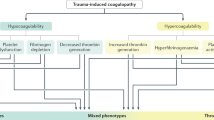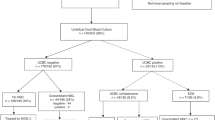Abstract
Objective:
To evaluate the efficacy and safety of passive cooling during transport of asphyxiated newborns.
Study Design:
Retrospective medical record review of newborns with perinatal asphyxia transported for hypothermia between July 2007 and June 2010.
Result:
Of 43 newborns transported, 27 were passively cooled without significant adverse events. Twenty (74%) passively cooled newborns arrived with temperature between 32.5 and 34.5 °C. One newborn arrived with a temperature <32.5, and 6 (22%) had temperatures >34.5 °C. Time from birth to hypothermia was significantly shorter among passively cooled newborns compared with newborns not cooled (215 vs 327 min, P<0.01), even though time from birth to admission to Boston Children’s Hospital was similar (252 vs 259 min, P=0.77). Time from birth to admission was the only significant predictor of increased time to reach target temperature (P=0.001).
Conclusion:
Exclusive passive cooling achieves significantly earlier initiation of effective hypothermia for asphyxiated newborns but should not delay transport for active cooling.
This is a preview of subscription content, access via your institution
Access options
Subscribe to this journal
Receive 12 print issues and online access
$259.00 per year
only $21.58 per issue
Buy this article
- Purchase on Springer Link
- Instant access to full article PDF
Prices may be subject to local taxes which are calculated during checkout

Similar content being viewed by others
References
Gluckman PD, Wyatt JS, Azzopardi D, Ballard R, Edwards AD, Ferriero DM et al. Selective head cooling with mild systemic hypothermia after neonatal encephalopathy: multicentre randomised trial. Lancet 2005; 365 (9460): 663–670.
Shankaran S, Laptook AR, Ehrenkranz RA, Tyson JE, McDonald SA, Donovan EF et al. Whole-body hypothermia for neonates with hypoxic-ischemic encephalopathy. N Engl J Med 2005; 353 (15): 1574–1584.
Azzopardi DV, Strohm B, Edwards AD, Dyet L, Halliday HL, Juszczak E et al. Moderate hypothermia to treat perinatal asphyxial encephalopathy. N Engl J Med 2009; 361 (14): 1349–1358.
Simbruner G, Mittal RA, Rohlmann F, Muche R . Systemic hypothermia after neonatal encephalopathy: outcomes of neo.nEURO.network RCT. Pediatrics 2010; 126 (4): e771–e778.
Perlman JM . Summary proceedings from the neurology group on hypoxic-ischemic encephalopathy. Pediatrics 2006; 117 (3 Part 2): S28–S33.
Hoehn T, Hansmann G, Buhrer C, Simbruner G, Gunn AJ, Yager J et al. Therapeutic hypothermia in neonates. Review of current clinical data, ILCOR recommendations and suggestions for implementation in neonatal intensive care units. Resuscitation 2008; 78 (1): 7–12.
Gunn AJ, Hoehn T, Hansmann G, Buhrer C, Simbruner G, Yager J et al. Hypothermia: an evolving treatment for neonatal hypoxic ischemic encephalopathy. Pediatrics 2008; 121 (3): 648–649.
Wyatt JS, Edwards AD, Azzopardi D, Reynolds EO . Magnetic resonance and near infrared spectroscopy for investigation of perinatal hypoxic-ischaemic brain injury. Arch Dis Child 1989; 64 (7 Spec no.): 953–963.
Roth SC, Baudin J, Cady E, Johal K, Townsend JP, Wyatt JS et al. Relation of deranged neonatal cerebral oxidative metabolism with neurodevelopmental outcome and head circumference at 4 years. Dev Med Child Neurol 1997; 39 (11): 718–725.
Gunn AJ, Battin M, Gluckman PD, Gunn TR, Bennet L . Therapeutic hypothermia: from lab to NICU. J Perinat Med 2005; 33 (4): 340–346.
Gunn AJ, Gunn TR, de Haan HH, Williams CE, Gluckman PD . Dramatic neuronal rescue with prolonged selective head cooling after ischemia in fetal lambs. J Clin Invest 1997; 99 (2): 248–256.
Gunn AJ, Gunn TR, Gunning MI, Williams CE, Gluckman PD . Neuroprotection with prolonged head cooling started before postischemic seizures in fetal sheep. Pediatrics 1998; 102 (5): 1098–1106.
Gunn AJ, Bennet L, Gunning MI, Gluckman PD, Gunn TR . Cerebral hypothermia is not neuroprotective when started after postischemic seizures in fetal sheep. Pediatr Res 1999; 46 (3): 274–280.
Anderson ME, Longhofer TA, Phillips W, McRay DE . Passive cooling to initiate hypothermia for transported encephalopathic newborns. J Perinatol 2007; 27 (9): 592–593.
Hallberg B, Olson L, Bartocci M, Edqvist I, Blennow M . Passive induction of hypothermia during transport of asphyxiated infants: a risk of excessive cooling. Acta Paediatr 2009; 98 (6): 942–946.
Fairchild K, Sokora D, Scott J, Zanelli S . Therapeutic hypothermia on neonatal transport: 4-year experience in a single NICU. J Perinatol 2010; 30 (5): 324–329.
Kendall GS, Kapetanakis A, Ratnavel N, Azzopardi D, Robertson NJ . On behalf of the Cooling on Retrieval Study G. Passive cooling for initiation of therapeutic hypothermia in neonatal encephalopathy. Arch Dis Child Fetal Neonatal Ed 2010; 95 (6): F408–F412.
Falzon A, Grech V, Caruana B, Magro A, Attard-Montalto S . How reliable is axillary temperature measurement? Acta Paediatr 2003; 92 (3): 309–313.
Morley CJ, Hewson PH, Thornton AJ, Cole TJ . Axillary and rectal temperature measurements in infants. Arch Dis Child 1992; 67 (1): 122–125.
American Academy of Pediatrics. Committee on Fetus and Newborn. Hospital stay for healthy term newborns. Pediatrics 2010; 125 (2): 405–409.
Frank JD, Brown S . Thermometers and rectal perforations in the neonate. Arch Dis Child 1978; 53 (10): 824–825.
Greenbaum EI, Carson M, Kincannon WN, O'Loughlin BJ . Rectal thermometer-induced pneumoperitoneum in the newborn. Report of two cases. Pediatrics 1969; 44 (4): 539–542.
Eicher DJ, Wagner CL, Katikaneni LP, Hulsey TC, Bass WT, Kaufman DA et al. Moderate hypothermia in neonatal encephalopathy: efficacy outcomes. Pediatr Neurol 2005; 32 (1): 11–17.
Thoresen M . Supportive care during neuroprotective hypothermia in the term newborn: adverse effects and their prevention. Clin Perinatol 2008; 35 (4): 749–763.
Burnard ED, Cross KW . Rectal temperature in the newborn after birth asphyxia. Br Med J 1958; 2 (5106): 1197–1199.
Dahm LS, James LS . Newborn temperature and calculated heat loss in the delivery room. Pediatrics 1972; 49 (4): 504–513.
Johnston ED, Becher JC, Mitchell AP, Stenson BJ . Provision of servo-controlled cooling during neonatal transport. Arch Dis Child Fetal Neonatal Ed 2012; 97 (5): F365–F367.
Craig JV, Lancaster GA, Williamson PR, Smyth RL . Temperature measured at the axilla compared with rectum in children and young people: systematic review. BMJ 2000; 320 (7243): 1174–1178.
Acknowledgements
This work was supported in part by a grant from the Charles H Hood Foundation. We thank Shaye Moore and Elizabeth Jarvis for their assistance with the preparation of this manuscript.
Author information
Authors and Affiliations
Corresponding author
Ethics declarations
Competing interests
The authors declare no conflict of interest.
Rights and permissions
About this article
Cite this article
O'Reilly, D., Labrecque, M., O'Melia, M. et al. Passive cooling during transport of asphyxiated term newborns. J Perinatol 33, 435–440 (2013). https://doi.org/10.1038/jp.2012.138
Received:
Revised:
Accepted:
Published:
Issue Date:
DOI: https://doi.org/10.1038/jp.2012.138
Keywords
This article is cited by
-
Prevention of excessive hypothermia in infants with hypoxic ischemic encephalopathy prior to admission to a quaternary care center: a neonatal outreach educational project
Journal of Perinatology (2019)
-
Therapeutic Hypothermia in Neonatal Hypoxic-Ischemic Encephalopathy
Current Neurology and Neuroscience Reports (2019)
-
Passive therapeutic hypothermia during ambulance and helicopter secondary neonatal transport in neonates with hypoxic brain injury: a 10-year retrospective survey
Child's Nervous System (2018)



